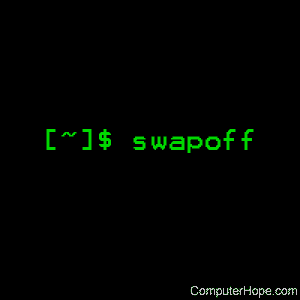Linux swapon and swapoff command

On Linux operating systems, the swapon and swapoff commands enable and disable, respectively, devices and files for paging and swapping.
Description
swapon is used to specify devices on which paging and swapping are to take place.
The device or file used is given by the specialfile parameter. It may be of the form "-L label" or "-U uuid" to indicate a device by label or uuid.
Calls to swapon normally occur in the system boot scripts making all swap devices available, so that the paging and swapping activity is interleaved across several devices and files.
swapoff disables swapping on the specified devices and files. When the -a flag is given, swapping is disabled on all known swap devices and files (as found in /proc/swaps or /etc/fstab).
Syntax
To get swap information:
swapon -s [-h] [-V]
To enable a swap area:
swapon [-d] [-f] [-p priority] [-v] specialfile...
To disable a swap area:
swapoff [-v] specialfile...
To enable all swap areas:
swapon -a [-e] [-f] [-v]
To disable all swap areas:
swapoff -a [-v]
Options
| -a, --all | All devices marked as "swap" in /etc/fstab are made available, except for those with the "noauto" option. Devices that are already used as swap are silently skipped. |
| -d, --discard | Discard freed swap pages before they are reused, if the swap device supports the discard or trim operation. This may improve performance on some solid-state devices, but often it does not. The /etc/fstab mount option discard may also be used to enable discard flag. |
| -e, --ifexists | Silently skip devices that do not exist. The /etc/fstab mount option nofail may also be used to skip non-existing device. |
| -f, --fixpgsz | Reinitialize (exec /sbin/mkswap) the swap space if its page size does not match that of the current running kernel. mkswap initializes the whole device and does not check for bad blocks. |
| -h, --help | Display a help message, and exit. |
| -L label | Use the partition with the specified label. (For this, access to /proc/partitions is needed.) |
| -p, --priority priority | Specify the priority of the swap device. The priority is a value between -1 and 32767. Higher numbers indicate higher priority. Add pri=value to the option field of /etc/fstab for use with swapon -a. If no priority is specified, it defaults to -1. |
| -s, --summary | Display swap usage summary by device. Equivalent to "cat /proc/swaps". Not available before Linux 2.1.25. |
| -U uuid | Use the partition with the specified UUID uuid. |
| -v, --verbose | Use verbose output. |
| -V, --version | Display version information, and exit. |
Notes
You should not use swapon on a file with holes (not contiguously represented on disk). Swap over NFS may not work. swapon automatically detects and rewrites swap space signature with old software suspend data (e.g., S1SUSPEND, S2SUSPEND, ...); otherwise, you can get data corruption the next time an attempt at unsuspending is made.
The swapon command may not work correctly when using a swap file with some versions of btrfs (B-Tree file system). Because the swap file implementation in the kernel expecting to be able to write to the file directly, without the assistance of the file system. Since btrfs is a copy-on-write file system, the file location may not be static and corruption can result. btrfs actively disallows the use of files on its file systems by refusing to map the file. This problem shown in the system log as "swapon: swapfile has holes." One possible workaround is to map the file to a loopback device, which allows the file system to determine the mapping properly but may come with a performance impact.
Examples
swapon /dev/sdc1
Enable the swap partition /dev/sdc1.
Related commands
fdisk — A disk partitioning utility.
init — The parent of all processes on the system.
mkswap — Set up a Linux swap area.
mount — Mount a file system so that its data may be accessed.
